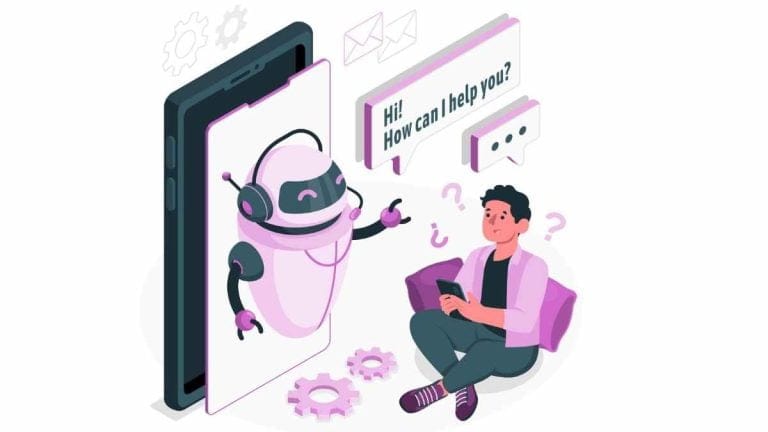Good customer service is all about providing positive, polite and timely responses to customers. It’s about solving customers’ problems and taking care of their needs by delivering professional, helpful, high-quality service and assistance before, during, and after their requirements are met.
Table of Contents
TogglePromptness, politeness, professionalism and personalization are the four core tenets of solid customer service – but it’s a busy and expensive operation to run. IBM estimates that 265 billion customer support tickets and calls are made globally every year, resulting in $1.3 trillion in customer service costs. As such, it’s no surprise that many companies are turning towards technologies such as automation, artificial intelligence (AI) and particularly chatbots to drive these numbers down. In fact, IBM cites a BI Intelligence figure purporting that implementing AI solutions, such as chatbots, into service workflows can reduce a business’s spend on customer service by up to 30%.

(Image source: chatbotsmagazine.com)
However, while organizations the world over continue to automate their customer service processes, consumers are still craving the human touch.
According to PwC’s 2018 “Experience Is Everything” report, 75% of global consumers and 82% of Americans said they wanted more human interaction from brands, not less, and 64% said they felt companies have lost touch with the human element of the customer experience.

(Image source: pwc.com)
Nonetheless, in an increasingly online world, customers are still demanding faster-than-ever response times from brands, and so technology must be deployed if adequate service is to be delivered. According to Forrester, 46% of global contact center decision-makers project their contact centers to grow by 5%-10% in the next year – an unsustainable rate using a human workforce alone. As such, AI will increasingly become a more mainstream customer service investment over the coming couple of years. By 2020, 25% of customer service and support operations will integrate virtual customer assistant or chatbot technology across engagement channels – up from less than 2% in 2017 – according to Gartner.
But, even as technology improves and automation becomes more prevalent, most American consumers still prefer human interaction. People engage with apps, websites, and chatbots – but as soon as something goes wrong, they want to talk a real person, stat. Though new technology can create savings and is often necessary in order to remain competitive, the human touch remains vitally important. In fact, according to PwC’s report, 71% of Americans would rather interact with a human than a chatbot or some other automated process.
And so, the challenge is on. How do firms utilize automated customer service technology – as they must – without creating frustrations for customers, hurting relationships, and losing the human touch?
The Limitations of Customer Service Chatbots
When it comes to AI, what’s important to remember is that the purpose of the technology is not to replace people, but to function alongside them and enable them to work faster and smarter.
Many companies are of course already using chatbots to provide instant online customer support. The AI software in these bots is perfectly capable of answering multiple questions on routine issues coming from multiple customers simultaneously – freeing up human time and resources.
However, the machine learning algorithms that power them, though they are becoming increasingly sophisticated, still don’t have the ability to truly understand human emotions and a lot of the nuances and vagaries of human conversation. This means that while chatbots are most certainly useful in dealing with basic issues, they fall short when it comes to more complex matters. In short, the problem is that the software still can’t contextualize data – the basic requirement for real human-like conversation.
What’s more, they can’t provide the human reasoning required to diagnose a customer problem. Nor can they understand the mistakes that might have been made – the mishandling of information between departments, for instance – that may lead to a customer reaching out to lodge a complaint or ask for support.
Put simply, there is a limit to the complexity and range of questions a chatbot is able to handle. As such, when a bot can’t provide an answer, it’s imperative that a system is in place for the responsibility to be passed over to a human member of the service team to take over.
Collaborative Bots
Solutions are available to companies looking to solve the customer service chatbot challenge, namely in the form of online AI-powered bots that can collaborate with human representatives to maximize companies’ interactions with customers.
For example, omnichannel customer experience management company Teleperformance has developed a customer service cognitive agent – known as TP BOT – which handles initial customer enquiries online, as most of these requests can be easily understood. However, as soon as TP BOT cannot confidently handle a question, the chat is immediately passed to a human agent via an automated customer service process flow, allowing the agent to continue the conversation where the bot left off.
In addition, TP BOT is also able to support human agents during chats with customers. For example, the bot can analyze vast amounts of customer data – more than human agents could analyze on their own during a call – and highlight for the agent the most relevant details based on the problem the customer is experiencing. This allows the human agent to respond immediately to the customer without having to search through multiple sources.
This tag-team effort allows customer service departments to handle higher volumes of interactions than they would otherwise be able to in the first instance, while still being able to focus on solving more complex problems with greater accuracy and efficiency in the second – and all without losing the personalized touch that consumers crave.
Final Thoughts
Ultimately, technology needs to complement the human element of customer service, not replace or frustrate it. Some enquiries can be more than adequately handled with automation, though others can only be resolved by an experienced person who can connect with the customer on a human and emotional level.
When done right, utilizing the latest tech while keeping the human touch in mind will create outstanding customer service experiences, and companies that have found this sweet spot are reaping the benefits – 82% of the top-performing companies surveyed by PwC pay close attention to the human experience around digital and tech.
Technology isn’t the be all and end all of customer service, and organizations won’t be able to solve all of their problems with automation alone. Rather, balancing the hybrid demands for both digital service and the human touch will be winning. Companies need to and should take advantage of automation, but it must be ensured that customers can always reach a real human quickly and seamlessly when one is needed.
Summary:
Retain Human Element When Automating
Promptness, politeness, professionalism and personalization are the four core tenets of solid customer service – but it’s a busy and expensive operation to run. IBM estimates that 265 billion customer support tickets and calls are made globally every year, resulting in $1.3 trillion in customer service costs. As such, it’s no surprise that many companies are turning towards technologies such as automation, artificial intelligence (AI) and particularly chatbots to drive these numbers down. However, while organizations the world over continue to automate their customer service processes, consumers are still craving the human touch. According to PwC’s 2018 “Experience Is Everything” report, 75% of global consumers and 82% of Americans said they wanted more human interaction from brands, not less, and 64% said they felt companies have lost touch with the human element of the customer experience. Solutions are available to companies looking to solve the customer service chatbot challenge, namely in the form of online AI-powered bots that can collaborate with human representatives to maximize companies’ interactions with customers. For example, omnichannel customer experience management company Teleperformance has developed a customer service cognitive agent – known as TP BOT – which handles initial customer enquiries online, as most of these requests can be easily understood. However, as soon as TP BOT cannot confidently handle a question, the chat is immediately passed to a human agent via an automated customer service process flow, allowing the agent to continue the conversation where the bot left off. In addition, TP BOT is also able to support human agents during chats with customers. For example, the bot can analyze vast amounts of customer data – more than human agents could analyze on their own during a call – and highlight for the agent the most relevant details based on the problem the customer is experiencing. This allows the human agent to respond immediately to the customer without having to search through multiple sources.






